An Analysis of Global Economics and Techniques: A Detailed Report
VerifiedAdded on 2022/07/20
|6
|2354
|29
Report
AI Summary
This report provides an overview of global economics and techniques, focusing on the growth of the global knowledge economy and its impact on regional development. It explores the concept of learning regions, emphasizing the role of knowledge, innovation, and international cooperation in fostering economic growth. The report analyzes various aspects, including the spatial clustering of knowledge, the importance of infrastructure, and the challenges faced by different regions. It also reviews literature on creative regions, learning economies, and the role of ICT and digitalization. Furthermore, the report examines the dynamics of innovation, the significance of both incremental and breakthrough innovations, and the role of international cooperation in the future. The analysis covers the importance of knowledge and institutions, emphasizing their region-specific nature and the challenges of homogenization in the era of globalization. The report concludes by highlighting the increasing significance of knowledge in determining regional learning and expansion, advocating for the development of international relationships for higher education institutions.
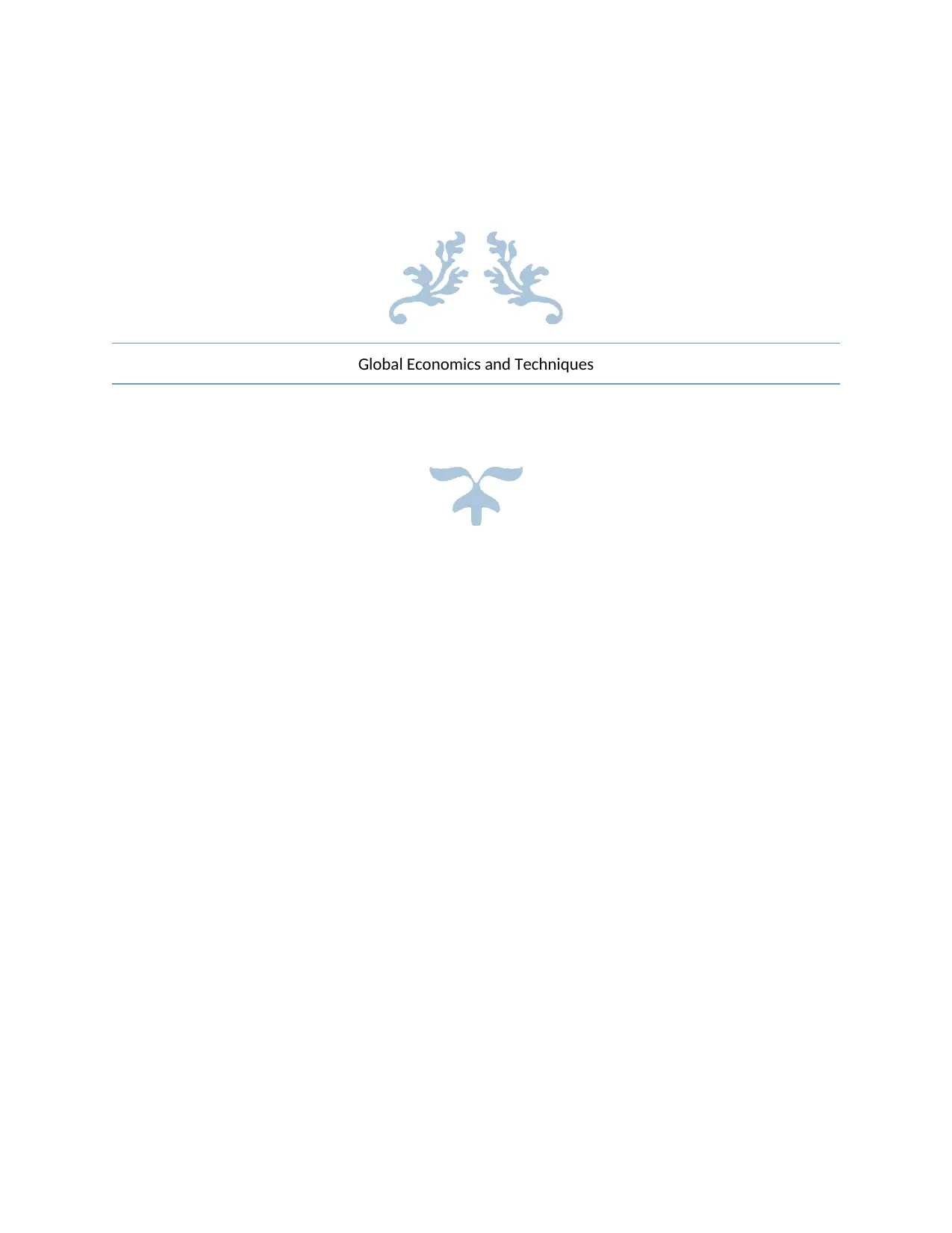
Global Economics and Techniques
Paraphrase This Document
Need a fresh take? Get an instant paraphrase of this document with our AI Paraphraser
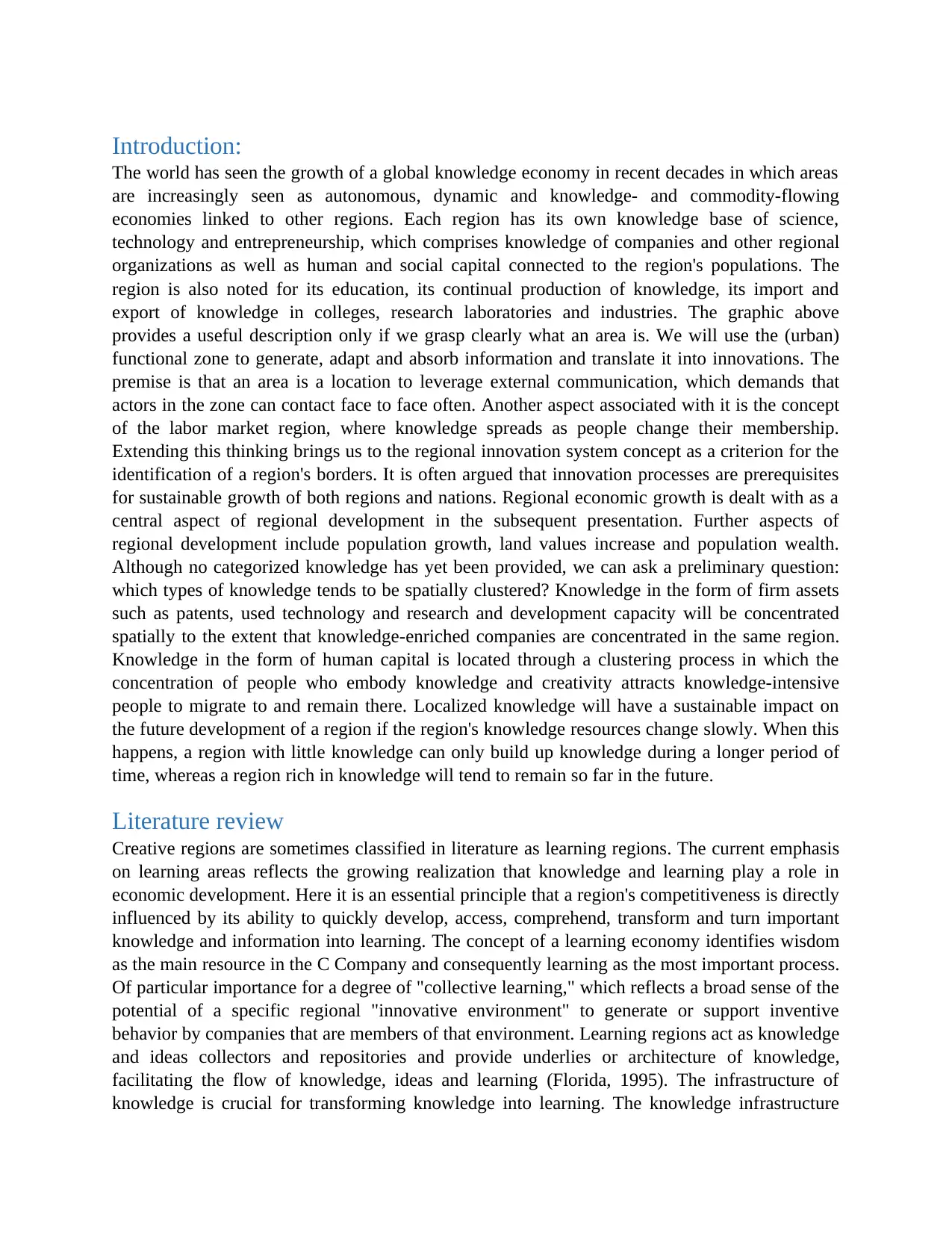
Introduction:
The world has seen the growth of a global knowledge economy in recent decades in which areas
are increasingly seen as autonomous, dynamic and knowledge- and commodity-flowing
economies linked to other regions. Each region has its own knowledge base of science,
technology and entrepreneurship, which comprises knowledge of companies and other regional
organizations as well as human and social capital connected to the region's populations. The
region is also noted for its education, its continual production of knowledge, its import and
export of knowledge in colleges, research laboratories and industries. The graphic above
provides a useful description only if we grasp clearly what an area is. We will use the (urban)
functional zone to generate, adapt and absorb information and translate it into innovations. The
premise is that an area is a location to leverage external communication, which demands that
actors in the zone can contact face to face often. Another aspect associated with it is the concept
of the labor market region, where knowledge spreads as people change their membership.
Extending this thinking brings us to the regional innovation system concept as a criterion for the
identification of a region's borders. It is often argued that innovation processes are prerequisites
for sustainable growth of both regions and nations. Regional economic growth is dealt with as a
central aspect of regional development in the subsequent presentation. Further aspects of
regional development include population growth, land values increase and population wealth.
Although no categorized knowledge has yet been provided, we can ask a preliminary question:
which types of knowledge tends to be spatially clustered? Knowledge in the form of firm assets
such as patents, used technology and research and development capacity will be concentrated
spatially to the extent that knowledge-enriched companies are concentrated in the same region.
Knowledge in the form of human capital is located through a clustering process in which the
concentration of people who embody knowledge and creativity attracts knowledge-intensive
people to migrate to and remain there. Localized knowledge will have a sustainable impact on
the future development of a region if the region's knowledge resources change slowly. When this
happens, a region with little knowledge can only build up knowledge during a longer period of
time, whereas a region rich in knowledge will tend to remain so far in the future.
Literature review
Creative regions are sometimes classified in literature as learning regions. The current emphasis
on learning areas reflects the growing realization that knowledge and learning play a role in
economic development. Here it is an essential principle that a region's competitiveness is directly
influenced by its ability to quickly develop, access, comprehend, transform and turn important
knowledge and information into learning. The concept of a learning economy identifies wisdom
as the main resource in the C Company and consequently learning as the most important process.
Of particular importance for a degree of "collective learning," which reflects a broad sense of the
potential of a specific regional "innovative environment" to generate or support inventive
behavior by companies that are members of that environment. Learning regions act as knowledge
and ideas collectors and repositories and provide underlies or architecture of knowledge,
facilitating the flow of knowledge, ideas and learning (Florida, 1995). The infrastructure of
knowledge is crucial for transforming knowledge into learning. The knowledge infrastructure
The world has seen the growth of a global knowledge economy in recent decades in which areas
are increasingly seen as autonomous, dynamic and knowledge- and commodity-flowing
economies linked to other regions. Each region has its own knowledge base of science,
technology and entrepreneurship, which comprises knowledge of companies and other regional
organizations as well as human and social capital connected to the region's populations. The
region is also noted for its education, its continual production of knowledge, its import and
export of knowledge in colleges, research laboratories and industries. The graphic above
provides a useful description only if we grasp clearly what an area is. We will use the (urban)
functional zone to generate, adapt and absorb information and translate it into innovations. The
premise is that an area is a location to leverage external communication, which demands that
actors in the zone can contact face to face often. Another aspect associated with it is the concept
of the labor market region, where knowledge spreads as people change their membership.
Extending this thinking brings us to the regional innovation system concept as a criterion for the
identification of a region's borders. It is often argued that innovation processes are prerequisites
for sustainable growth of both regions and nations. Regional economic growth is dealt with as a
central aspect of regional development in the subsequent presentation. Further aspects of
regional development include population growth, land values increase and population wealth.
Although no categorized knowledge has yet been provided, we can ask a preliminary question:
which types of knowledge tends to be spatially clustered? Knowledge in the form of firm assets
such as patents, used technology and research and development capacity will be concentrated
spatially to the extent that knowledge-enriched companies are concentrated in the same region.
Knowledge in the form of human capital is located through a clustering process in which the
concentration of people who embody knowledge and creativity attracts knowledge-intensive
people to migrate to and remain there. Localized knowledge will have a sustainable impact on
the future development of a region if the region's knowledge resources change slowly. When this
happens, a region with little knowledge can only build up knowledge during a longer period of
time, whereas a region rich in knowledge will tend to remain so far in the future.
Literature review
Creative regions are sometimes classified in literature as learning regions. The current emphasis
on learning areas reflects the growing realization that knowledge and learning play a role in
economic development. Here it is an essential principle that a region's competitiveness is directly
influenced by its ability to quickly develop, access, comprehend, transform and turn important
knowledge and information into learning. The concept of a learning economy identifies wisdom
as the main resource in the C Company and consequently learning as the most important process.
Of particular importance for a degree of "collective learning," which reflects a broad sense of the
potential of a specific regional "innovative environment" to generate or support inventive
behavior by companies that are members of that environment. Learning regions act as knowledge
and ideas collectors and repositories and provide underlies or architecture of knowledge,
facilitating the flow of knowledge, ideas and learning (Florida, 1995). The infrastructure of
knowledge is crucial for transforming knowledge into learning. The knowledge infrastructure
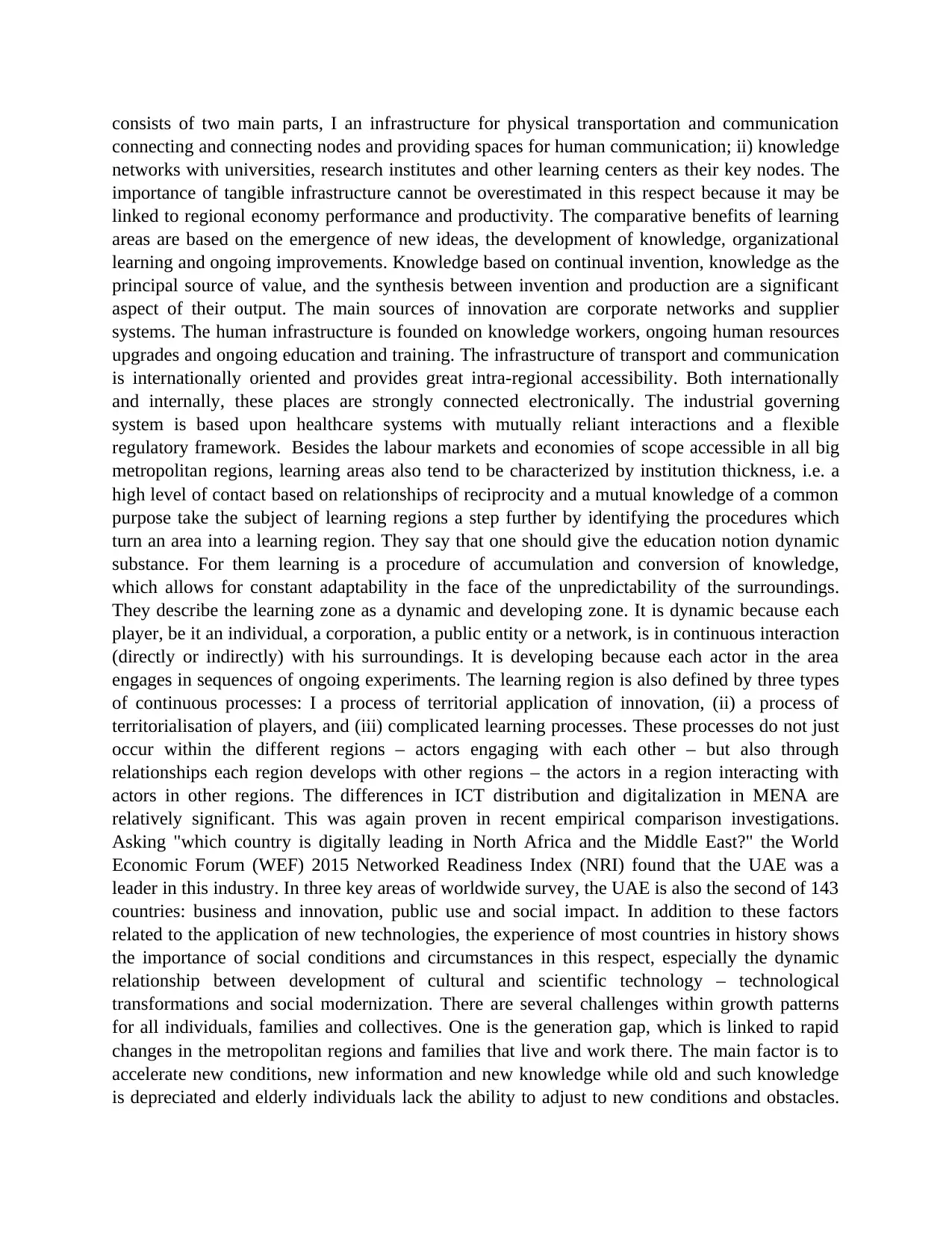
consists of two main parts, I an infrastructure for physical transportation and communication
connecting and connecting nodes and providing spaces for human communication; ii) knowledge
networks with universities, research institutes and other learning centers as their key nodes. The
importance of tangible infrastructure cannot be overestimated in this respect because it may be
linked to regional economy performance and productivity. The comparative benefits of learning
areas are based on the emergence of new ideas, the development of knowledge, organizational
learning and ongoing improvements. Knowledge based on continual invention, knowledge as the
principal source of value, and the synthesis between invention and production are a significant
aspect of their output. The main sources of innovation are corporate networks and supplier
systems. The human infrastructure is founded on knowledge workers, ongoing human resources
upgrades and ongoing education and training. The infrastructure of transport and communication
is internationally oriented and provides great intra-regional accessibility. Both internationally
and internally, these places are strongly connected electronically. The industrial governing
system is based upon healthcare systems with mutually reliant interactions and a flexible
regulatory framework. Besides the labour markets and economies of scope accessible in all big
metropolitan regions, learning areas also tend to be characterized by institution thickness, i.e. a
high level of contact based on relationships of reciprocity and a mutual knowledge of a common
purpose take the subject of learning regions a step further by identifying the procedures which
turn an area into a learning region. They say that one should give the education notion dynamic
substance. For them learning is a procedure of accumulation and conversion of knowledge,
which allows for constant adaptability in the face of the unpredictability of the surroundings.
They describe the learning zone as a dynamic and developing zone. It is dynamic because each
player, be it an individual, a corporation, a public entity or a network, is in continuous interaction
(directly or indirectly) with his surroundings. It is developing because each actor in the area
engages in sequences of ongoing experiments. The learning region is also defined by three types
of continuous processes: I a process of territorial application of innovation, (ii) a process of
territorialisation of players, and (iii) complicated learning processes. These processes do not just
occur within the different regions – actors engaging with each other – but also through
relationships each region develops with other regions – the actors in a region interacting with
actors in other regions. The differences in ICT distribution and digitalization in MENA are
relatively significant. This was again proven in recent empirical comparison investigations.
Asking "which country is digitally leading in North Africa and the Middle East?" the World
Economic Forum (WEF) 2015 Networked Readiness Index (NRI) found that the UAE was a
leader in this industry. In three key areas of worldwide survey, the UAE is also the second of 143
countries: business and innovation, public use and social impact. In addition to these factors
related to the application of new technologies, the experience of most countries in history shows
the importance of social conditions and circumstances in this respect, especially the dynamic
relationship between development of cultural and scientific technology – technological
transformations and social modernization. There are several challenges within growth patterns
for all individuals, families and collectives. One is the generation gap, which is linked to rapid
changes in the metropolitan regions and families that live and work there. The main factor is to
accelerate new conditions, new information and new knowledge while old and such knowledge
is depreciated and elderly individuals lack the ability to adjust to new conditions and obstacles.
connecting and connecting nodes and providing spaces for human communication; ii) knowledge
networks with universities, research institutes and other learning centers as their key nodes. The
importance of tangible infrastructure cannot be overestimated in this respect because it may be
linked to regional economy performance and productivity. The comparative benefits of learning
areas are based on the emergence of new ideas, the development of knowledge, organizational
learning and ongoing improvements. Knowledge based on continual invention, knowledge as the
principal source of value, and the synthesis between invention and production are a significant
aspect of their output. The main sources of innovation are corporate networks and supplier
systems. The human infrastructure is founded on knowledge workers, ongoing human resources
upgrades and ongoing education and training. The infrastructure of transport and communication
is internationally oriented and provides great intra-regional accessibility. Both internationally
and internally, these places are strongly connected electronically. The industrial governing
system is based upon healthcare systems with mutually reliant interactions and a flexible
regulatory framework. Besides the labour markets and economies of scope accessible in all big
metropolitan regions, learning areas also tend to be characterized by institution thickness, i.e. a
high level of contact based on relationships of reciprocity and a mutual knowledge of a common
purpose take the subject of learning regions a step further by identifying the procedures which
turn an area into a learning region. They say that one should give the education notion dynamic
substance. For them learning is a procedure of accumulation and conversion of knowledge,
which allows for constant adaptability in the face of the unpredictability of the surroundings.
They describe the learning zone as a dynamic and developing zone. It is dynamic because each
player, be it an individual, a corporation, a public entity or a network, is in continuous interaction
(directly or indirectly) with his surroundings. It is developing because each actor in the area
engages in sequences of ongoing experiments. The learning region is also defined by three types
of continuous processes: I a process of territorial application of innovation, (ii) a process of
territorialisation of players, and (iii) complicated learning processes. These processes do not just
occur within the different regions – actors engaging with each other – but also through
relationships each region develops with other regions – the actors in a region interacting with
actors in other regions. The differences in ICT distribution and digitalization in MENA are
relatively significant. This was again proven in recent empirical comparison investigations.
Asking "which country is digitally leading in North Africa and the Middle East?" the World
Economic Forum (WEF) 2015 Networked Readiness Index (NRI) found that the UAE was a
leader in this industry. In three key areas of worldwide survey, the UAE is also the second of 143
countries: business and innovation, public use and social impact. In addition to these factors
related to the application of new technologies, the experience of most countries in history shows
the importance of social conditions and circumstances in this respect, especially the dynamic
relationship between development of cultural and scientific technology – technological
transformations and social modernization. There are several challenges within growth patterns
for all individuals, families and collectives. One is the generation gap, which is linked to rapid
changes in the metropolitan regions and families that live and work there. The main factor is to
accelerate new conditions, new information and new knowledge while old and such knowledge
is depreciated and elderly individuals lack the ability to adjust to new conditions and obstacles.
⊘ This is a preview!⊘
Do you want full access?
Subscribe today to unlock all pages.

Trusted by 1+ million students worldwide
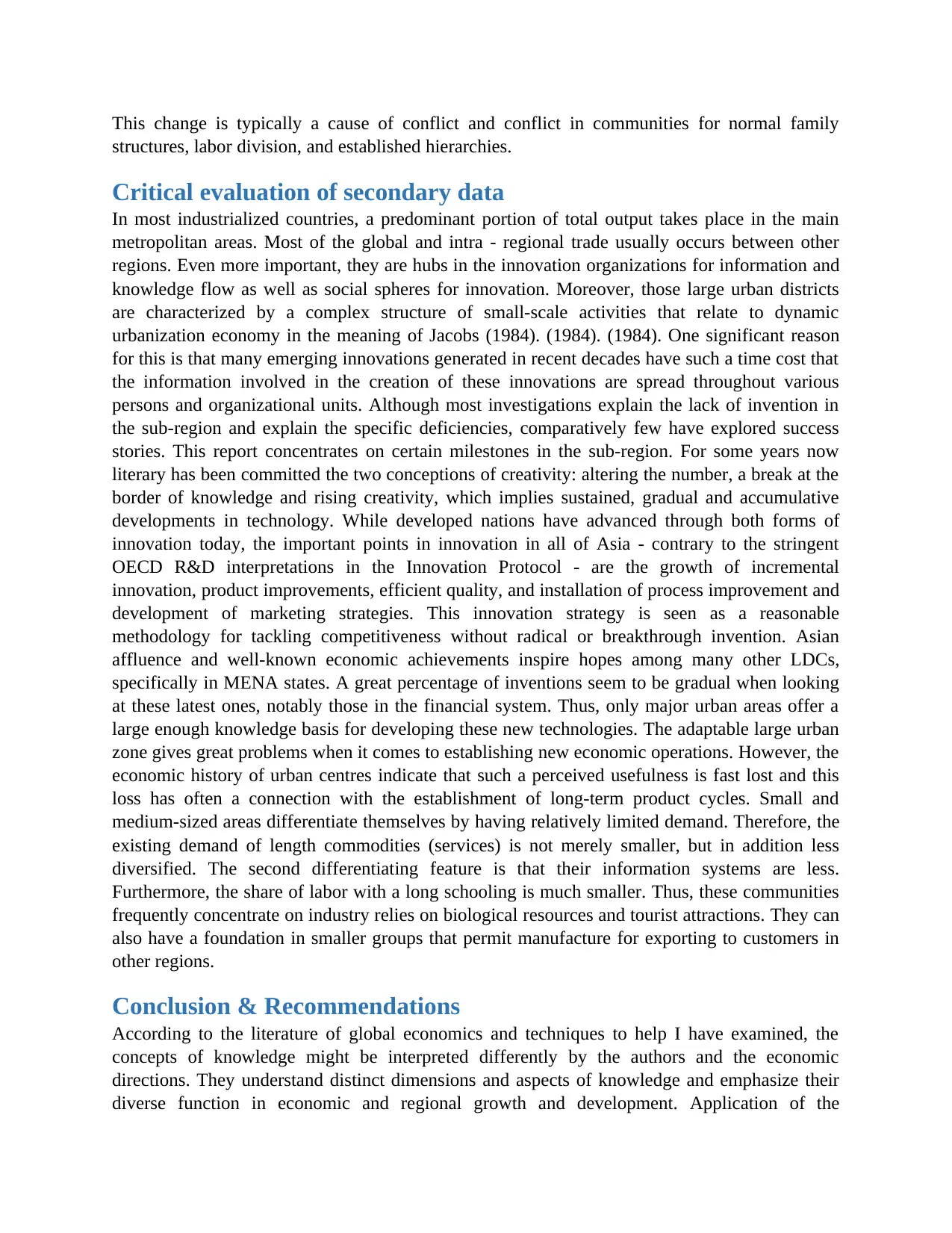
This change is typically a cause of conflict and conflict in communities for normal family
structures, labor division, and established hierarchies.
Critical evaluation of secondary data
In most industrialized countries, a predominant portion of total output takes place in the main
metropolitan areas. Most of the global and intra - regional trade usually occurs between other
regions. Even more important, they are hubs in the innovation organizations for information and
knowledge flow as well as social spheres for innovation. Moreover, those large urban districts
are characterized by a complex structure of small-scale activities that relate to dynamic
urbanization economy in the meaning of Jacobs (1984). (1984). (1984). One significant reason
for this is that many emerging innovations generated in recent decades have such a time cost that
the information involved in the creation of these innovations are spread throughout various
persons and organizational units. Although most investigations explain the lack of invention in
the sub-region and explain the specific deficiencies, comparatively few have explored success
stories. This report concentrates on certain milestones in the sub-region. For some years now
literary has been committed the two conceptions of creativity: altering the number, a break at the
border of knowledge and rising creativity, which implies sustained, gradual and accumulative
developments in technology. While developed nations have advanced through both forms of
innovation today, the important points in innovation in all of Asia - contrary to the stringent
OECD R&D interpretations in the Innovation Protocol - are the growth of incremental
innovation, product improvements, efficient quality, and installation of process improvement and
development of marketing strategies. This innovation strategy is seen as a reasonable
methodology for tackling competitiveness without radical or breakthrough invention. Asian
affluence and well-known economic achievements inspire hopes among many other LDCs,
specifically in MENA states. A great percentage of inventions seem to be gradual when looking
at these latest ones, notably those in the financial system. Thus, only major urban areas offer a
large enough knowledge basis for developing these new technologies. The adaptable large urban
zone gives great problems when it comes to establishing new economic operations. However, the
economic history of urban centres indicate that such a perceived usefulness is fast lost and this
loss has often a connection with the establishment of long-term product cycles. Small and
medium-sized areas differentiate themselves by having relatively limited demand. Therefore, the
existing demand of length commodities (services) is not merely smaller, but in addition less
diversified. The second differentiating feature is that their information systems are less.
Furthermore, the share of labor with a long schooling is much smaller. Thus, these communities
frequently concentrate on industry relies on biological resources and tourist attractions. They can
also have a foundation in smaller groups that permit manufacture for exporting to customers in
other regions.
Conclusion & Recommendations
According to the literature of global economics and techniques to help I have examined, the
concepts of knowledge might be interpreted differently by the authors and the economic
directions. They understand distinct dimensions and aspects of knowledge and emphasize their
diverse function in economic and regional growth and development. Application of the
structures, labor division, and established hierarchies.
Critical evaluation of secondary data
In most industrialized countries, a predominant portion of total output takes place in the main
metropolitan areas. Most of the global and intra - regional trade usually occurs between other
regions. Even more important, they are hubs in the innovation organizations for information and
knowledge flow as well as social spheres for innovation. Moreover, those large urban districts
are characterized by a complex structure of small-scale activities that relate to dynamic
urbanization economy in the meaning of Jacobs (1984). (1984). (1984). One significant reason
for this is that many emerging innovations generated in recent decades have such a time cost that
the information involved in the creation of these innovations are spread throughout various
persons and organizational units. Although most investigations explain the lack of invention in
the sub-region and explain the specific deficiencies, comparatively few have explored success
stories. This report concentrates on certain milestones in the sub-region. For some years now
literary has been committed the two conceptions of creativity: altering the number, a break at the
border of knowledge and rising creativity, which implies sustained, gradual and accumulative
developments in technology. While developed nations have advanced through both forms of
innovation today, the important points in innovation in all of Asia - contrary to the stringent
OECD R&D interpretations in the Innovation Protocol - are the growth of incremental
innovation, product improvements, efficient quality, and installation of process improvement and
development of marketing strategies. This innovation strategy is seen as a reasonable
methodology for tackling competitiveness without radical or breakthrough invention. Asian
affluence and well-known economic achievements inspire hopes among many other LDCs,
specifically in MENA states. A great percentage of inventions seem to be gradual when looking
at these latest ones, notably those in the financial system. Thus, only major urban areas offer a
large enough knowledge basis for developing these new technologies. The adaptable large urban
zone gives great problems when it comes to establishing new economic operations. However, the
economic history of urban centres indicate that such a perceived usefulness is fast lost and this
loss has often a connection with the establishment of long-term product cycles. Small and
medium-sized areas differentiate themselves by having relatively limited demand. Therefore, the
existing demand of length commodities (services) is not merely smaller, but in addition less
diversified. The second differentiating feature is that their information systems are less.
Furthermore, the share of labor with a long schooling is much smaller. Thus, these communities
frequently concentrate on industry relies on biological resources and tourist attractions. They can
also have a foundation in smaller groups that permit manufacture for exporting to customers in
other regions.
Conclusion & Recommendations
According to the literature of global economics and techniques to help I have examined, the
concepts of knowledge might be interpreted differently by the authors and the economic
directions. They understand distinct dimensions and aspects of knowledge and emphasize their
diverse function in economic and regional growth and development. Application of the
Paraphrase This Document
Need a fresh take? Get an instant paraphrase of this document with our AI Paraphraser
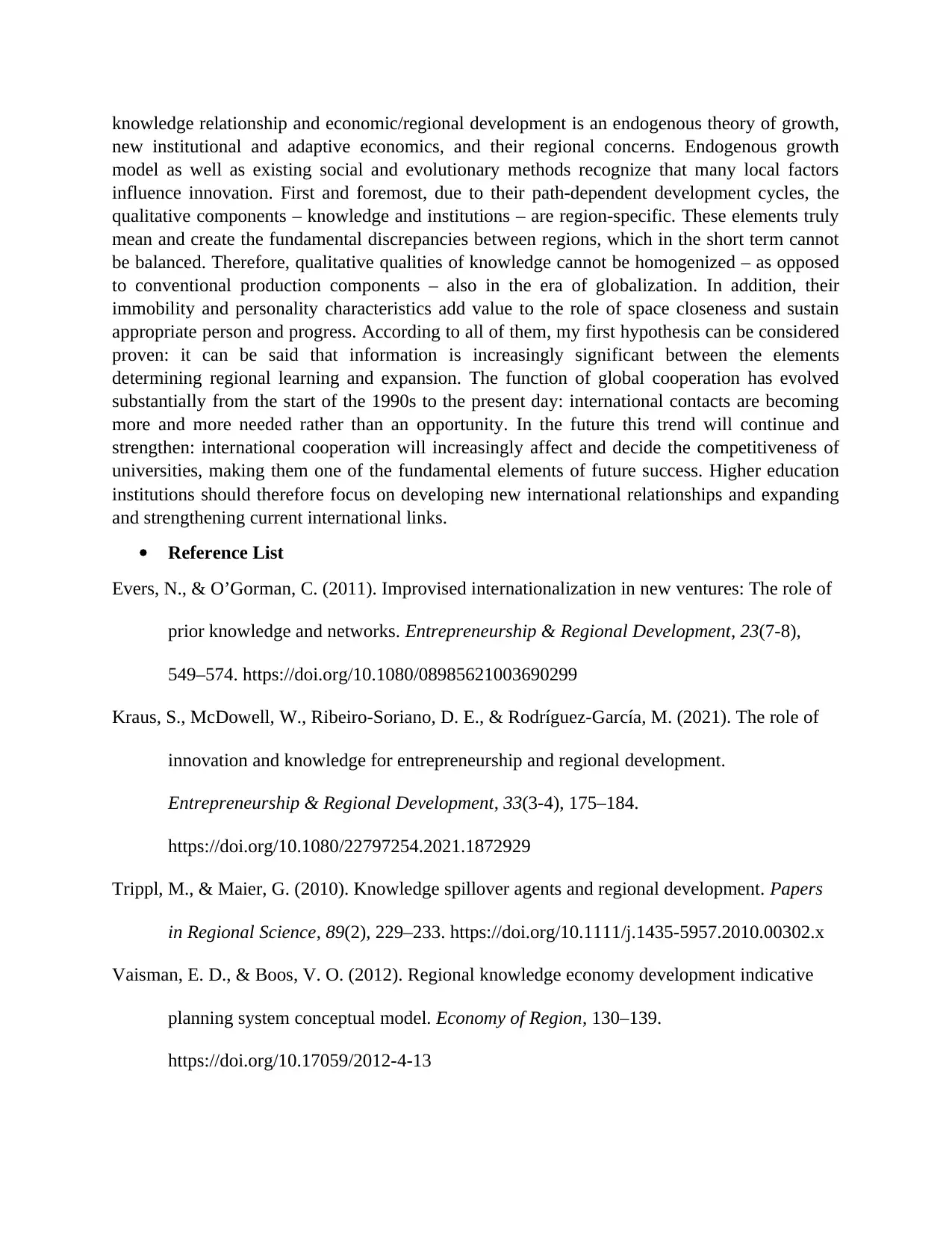
knowledge relationship and economic/regional development is an endogenous theory of growth,
new institutional and adaptive economics, and their regional concerns. Endogenous growth
model as well as existing social and evolutionary methods recognize that many local factors
influence innovation. First and foremost, due to their path-dependent development cycles, the
qualitative components – knowledge and institutions – are region-specific. These elements truly
mean and create the fundamental discrepancies between regions, which in the short term cannot
be balanced. Therefore, qualitative qualities of knowledge cannot be homogenized – as opposed
to conventional production components – also in the era of globalization. In addition, their
immobility and personality characteristics add value to the role of space closeness and sustain
appropriate person and progress. According to all of them, my first hypothesis can be considered
proven: it can be said that information is increasingly significant between the elements
determining regional learning and expansion. The function of global cooperation has evolved
substantially from the start of the 1990s to the present day: international contacts are becoming
more and more needed rather than an opportunity. In the future this trend will continue and
strengthen: international cooperation will increasingly affect and decide the competitiveness of
universities, making them one of the fundamental elements of future success. Higher education
institutions should therefore focus on developing new international relationships and expanding
and strengthening current international links.
Reference List
Evers, N., & O’Gorman, C. (2011). Improvised internationalization in new ventures: The role of
prior knowledge and networks. Entrepreneurship & Regional Development, 23(7-8),
549–574. https://doi.org/10.1080/08985621003690299
Kraus, S., McDowell, W., Ribeiro-Soriano, D. E., & Rodríguez-García, M. (2021). The role of
innovation and knowledge for entrepreneurship and regional development.
Entrepreneurship & Regional Development, 33(3-4), 175–184.
https://doi.org/10.1080/22797254.2021.1872929
Trippl, M., & Maier, G. (2010). Knowledge spillover agents and regional development. Papers
in Regional Science, 89(2), 229–233. https://doi.org/10.1111/j.1435-5957.2010.00302.x
Vaisman, E. D., & Boos, V. O. (2012). Regional knowledge economy development indicative
planning system conceptual model. Economy of Region, 130–139.
https://doi.org/10.17059/2012-4-13
new institutional and adaptive economics, and their regional concerns. Endogenous growth
model as well as existing social and evolutionary methods recognize that many local factors
influence innovation. First and foremost, due to their path-dependent development cycles, the
qualitative components – knowledge and institutions – are region-specific. These elements truly
mean and create the fundamental discrepancies between regions, which in the short term cannot
be balanced. Therefore, qualitative qualities of knowledge cannot be homogenized – as opposed
to conventional production components – also in the era of globalization. In addition, their
immobility and personality characteristics add value to the role of space closeness and sustain
appropriate person and progress. According to all of them, my first hypothesis can be considered
proven: it can be said that information is increasingly significant between the elements
determining regional learning and expansion. The function of global cooperation has evolved
substantially from the start of the 1990s to the present day: international contacts are becoming
more and more needed rather than an opportunity. In the future this trend will continue and
strengthen: international cooperation will increasingly affect and decide the competitiveness of
universities, making them one of the fundamental elements of future success. Higher education
institutions should therefore focus on developing new international relationships and expanding
and strengthening current international links.
Reference List
Evers, N., & O’Gorman, C. (2011). Improvised internationalization in new ventures: The role of
prior knowledge and networks. Entrepreneurship & Regional Development, 23(7-8),
549–574. https://doi.org/10.1080/08985621003690299
Kraus, S., McDowell, W., Ribeiro-Soriano, D. E., & Rodríguez-García, M. (2021). The role of
innovation and knowledge for entrepreneurship and regional development.
Entrepreneurship & Regional Development, 33(3-4), 175–184.
https://doi.org/10.1080/22797254.2021.1872929
Trippl, M., & Maier, G. (2010). Knowledge spillover agents and regional development. Papers
in Regional Science, 89(2), 229–233. https://doi.org/10.1111/j.1435-5957.2010.00302.x
Vaisman, E. D., & Boos, V. O. (2012). Regional knowledge economy development indicative
planning system conceptual model. Economy of Region, 130–139.
https://doi.org/10.17059/2012-4-13
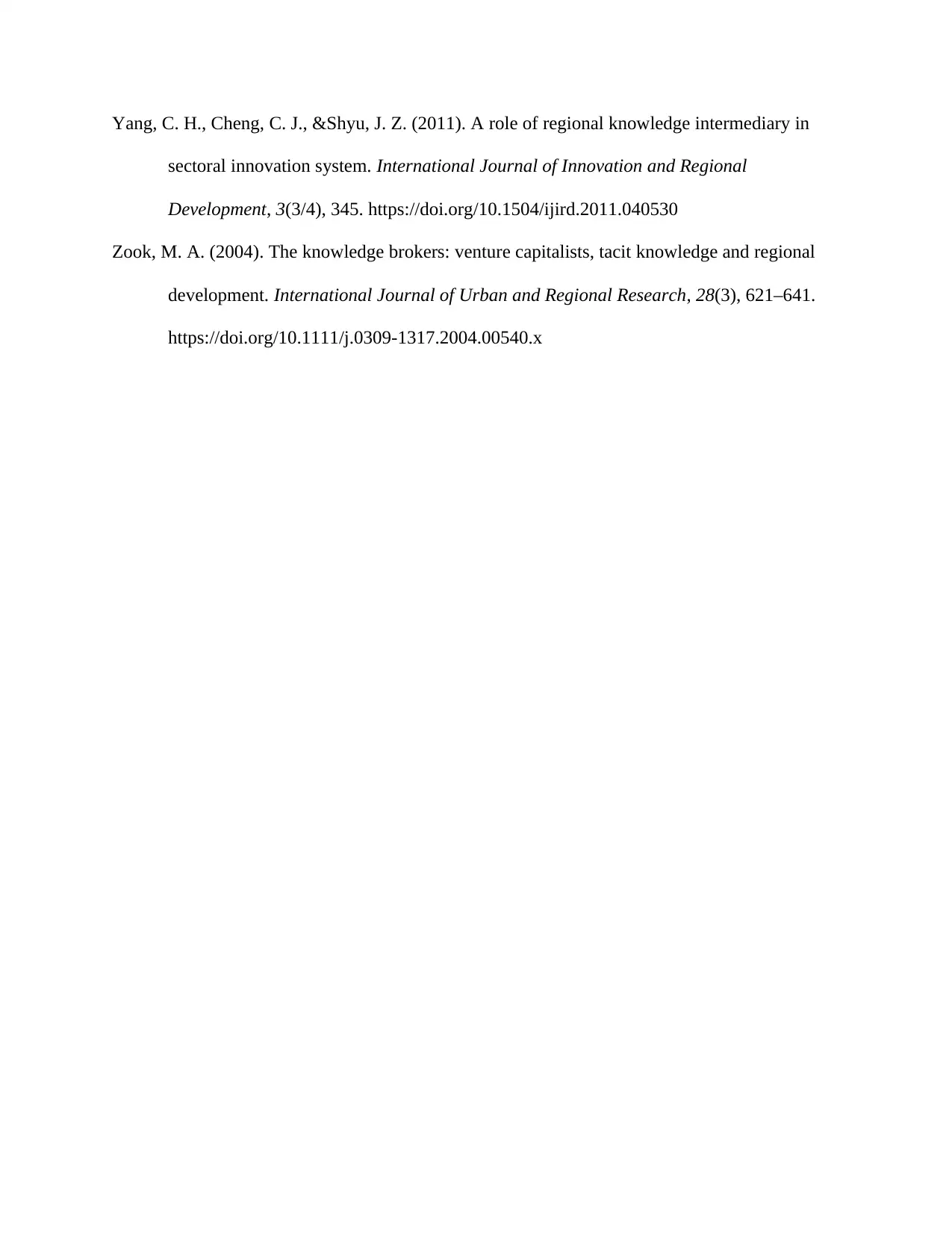
Yang, C. H., Cheng, C. J., &Shyu, J. Z. (2011). A role of regional knowledge intermediary in
sectoral innovation system. International Journal of Innovation and Regional
Development, 3(3/4), 345. https://doi.org/10.1504/ijird.2011.040530
Zook, M. A. (2004). The knowledge brokers: venture capitalists, tacit knowledge and regional
development. International Journal of Urban and Regional Research, 28(3), 621–641.
https://doi.org/10.1111/j.0309-1317.2004.00540.x
sectoral innovation system. International Journal of Innovation and Regional
Development, 3(3/4), 345. https://doi.org/10.1504/ijird.2011.040530
Zook, M. A. (2004). The knowledge brokers: venture capitalists, tacit knowledge and regional
development. International Journal of Urban and Regional Research, 28(3), 621–641.
https://doi.org/10.1111/j.0309-1317.2004.00540.x
⊘ This is a preview!⊘
Do you want full access?
Subscribe today to unlock all pages.

Trusted by 1+ million students worldwide
1 out of 6
Related Documents
Your All-in-One AI-Powered Toolkit for Academic Success.
+13062052269
info@desklib.com
Available 24*7 on WhatsApp / Email
![[object Object]](/_next/static/media/star-bottom.7253800d.svg)
Unlock your academic potential
Copyright © 2020–2025 A2Z Services. All Rights Reserved. Developed and managed by ZUCOL.





